Aruba Networks APEX0104 APEX104 User Manual SMHAP AP274 Manual r2x
Aruba Networks, Inc. APEX104 SMHAP AP274 Manual r2x
User Manual

2/16/2016 1 of 13 Rev. 2
LINDSAY BROADBAND INC
SMHAP-AP274
Installation
Guide

2/16/2016 2 of 13 Rev. 2
SMHAP-AP274
CONTENTS
I IMPORTANT SAFEGAURD & INSTALLATION WARNINGS
1. INSTALLATION
1.1 Pre-Installation
1.2 Site Selection
1.3 Power Requirements
1.4 Installation
1.5 Hanger Bracket Detail
2. PRODUCT DESCRIPTION
2.1 Introduction
2.2 General Description
2.3 Housing
2.4 HFC Interface
2.5 Block Diagram
3. COMPONENT IDENTIFICATION
3.1 Lid Component Identification Diagram
3.2 Base Component Identification Diagram
4. PRODUCT SPECIFICATIONS
5. REGULATORY NOTICES
Note: In this manual the term SMHAP refers to the SMHAP-AP274 only.

2/16/2016 3 of 13 Rev. 2
SMHAP-AP274
IMPORTANT SAFETY AND INSTALLATION WARNINGS
WARNING: DO NOT ATTEMPT TO SERVICE THIS PRODUCT YOURSELF AS
OPENING OR REMOVING COVERS MAY EXPOSE YOU TO DANGEROUS
VOLTAGES OR OTHER HAZARDS. REFER ALL SERVICING TO QUALIFIED
SERVICE PERSONNEL.
MOUNTING:
Mount this product only as described in the installation instructions, otherwise it
may fall causing serious personal injury and/or damage the unit. Use only with the
brackets supplied with the product. Do not use attachments not recommended for
this product as they may cause hazards.
SERVICING:
Remove power from this access controller and refer servicing to qualified personnel
under the following conditions:
1. If the inside of the station has been exposed to rain or water.
2. If the station does not operate normally by following the operating
instructions. Adjust only those controls that are covered by the operating
instructions as an improper adjustment of the controls may result in damage
and will often require extensive work by a qualified technician to restore the
unit to its normal operation.
3. If the unit has been dropped or the chassis has been damaged.
4. If the unit exhibits a distinct change in performance.
REPLACEMENT PARTS:
When replacement parts are required, be sure the service technician has used
replacement parts specified by the manufacturer or have the same characteristics
as the original part. Unauthorized substitutions may result in fire, electric shock or
other hazards.
SERVICE DEPOT:
Canada: Lindsay Broadband Inc.,
2035-2 Fisher Dr.
Peterborough, Ontario K9J 6X6
(705) 742-1350
!
Caution! Exposure to Radio Frequency Radiation
The antenna shall be placed in a manner that minimizes the potential for
human contact during normal operation. To avoid the possibility of exceeding
the FCC radio frequency exposure limits, human proximity to the antenna
shall not be less than 20 cm (8 inches) during normal operation.
Prudence! L'exposition aux Rayonnements à Fréquence Radioélectrique
Pour respecter les limites FCC d'exposition aux fréquences radio (RF), les
antennes doivent être placées à 20 cm (8 po) au moins de toute personne.
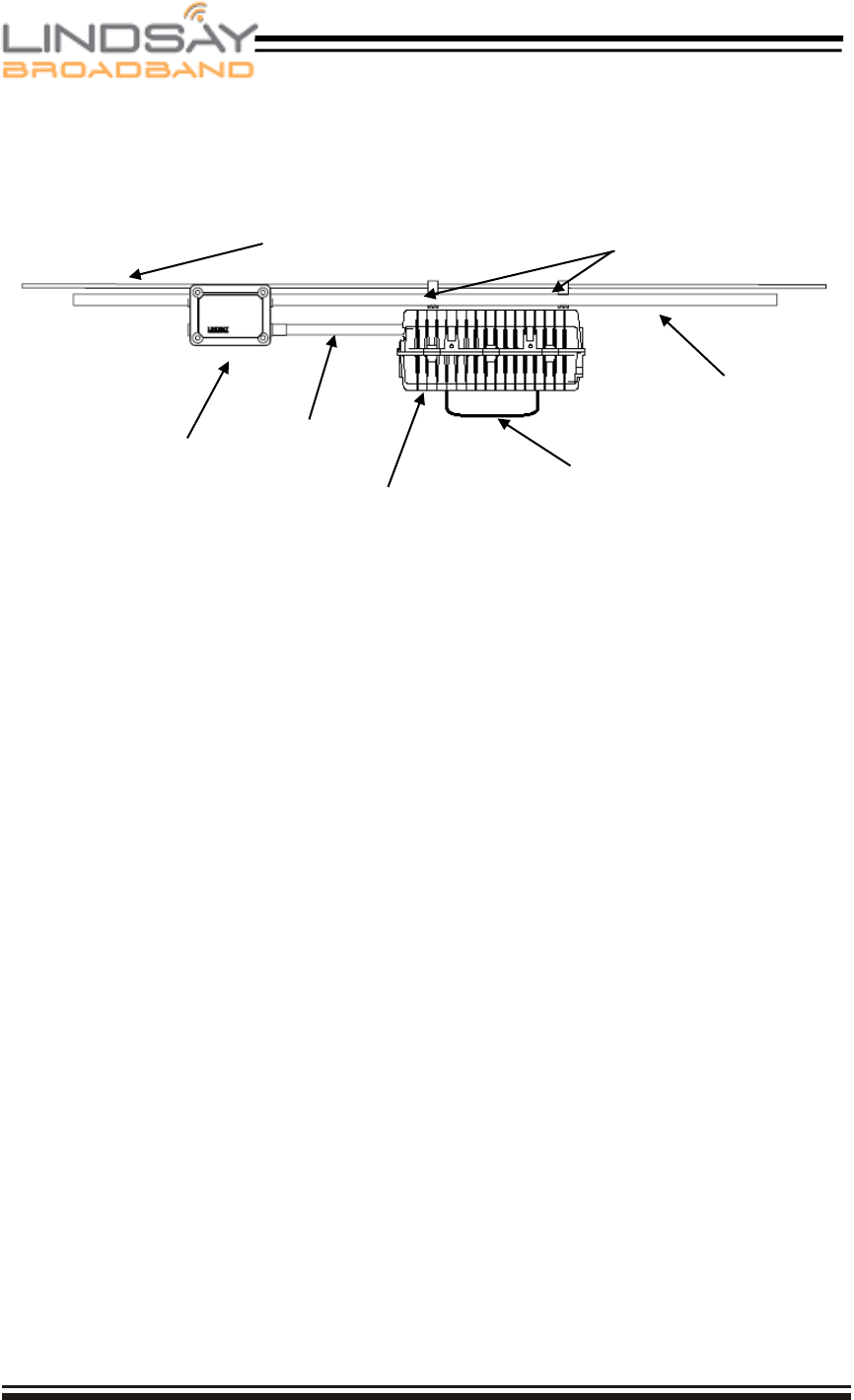
2/16/2016 4 of 13 Rev. 2
SMHAP-AP274
Strand
Clamps
Coupler
Hardline
SMHAP
Antenna
75 Ohm
Coax
Strand
Installation Overview
SECTION 1 INSTALLATION
1.1 Pre-Installation
Upon receipt of the access controller, inspect the carton for any external damage. If damage is
present inspect the SMHAP exterior for damage. Report any apparent damage to the shipping
agent and Lindsay Broadband sales office.
Pad values should be determined ahead of time. When calculating pad values allow for the
loss of the internal HFC interface; 5dB in the forward direction and 4dB in the reverse
direction. Forward levels at the modem should be 0 dBm. This is about 5 dBm at the input
port. For best return path S/N, the reverse pad should be selected so as to have the cable
modem operate near its maximum output level (-50 to -52 dBm). This will result in a level
around 47dBm at the input port. The testpoint indicates levels 20 dB below those at the cable
modem.
The cable modem can be provisioned ahead of time using the MAC address located on the
label on the outside of the power lid
1.2 Site Selection
The SMHAP must be mounted so that it has an un-obstructed view of the target area. The
SMHAP can obtain its power and RF connection from any nearby power passing tap, splitter,
or coupler. The SMHAP can consume up to 37W of power.

2/16/2016 5 of 13 Rev. 2
SMHAP-AP274
1.3 Power Requirements
The SMHAP draws a maximum of 37 Watts. You can use the following formula to
calculate the maximum current draw for your installation:
1.4 Installation
Installation of the SMHAP is similar to the installation of a line extender, or tap, or other piece
of CATV equipment. Use the diagrams in this section as guide to the installation, and the
diagrams in section 2 to help locate the components referred to in the following instructions.
1. Pull the AC interrupt in the power passing tap or coupler.
2. Mount the SMHAP in its final location. When installing the back mount
hanger brackets, the existing strand clamps should be re-used to act as a
thick washer allowing the same bolts to be used (See section 1.5).
3. Open the lid and replace the two 0 dB RF pads with pad values that were
determined before entering the field.
4. Make a coaxial connection to the power-passing tap or coupler.
5. Re-install the AC interrupt. Indicator LEDS on the cable modem and radio
should indicate startup and discovery of their respective networks. (Refer to
the cable modem and access point installation guide for more information.)
6. The forward and reverse RF levels at the cable modem can be measured at
the single test point. Readings are -20dB relative to the cable modem F
connector. Make adjustments to pad values as required.
7. Silicone Grease can be applied to the exposed part of the O-ring before
swinging the lid back into place. This will reduce any tendency of the O-ring
to stick to the lid and ensure a weather-tight seal. To be clear, use Silicone
Grease, not Silicone Sealant, nor any other type of Grease.
8. If the EMI gasket has any frayed or loose ends tuck them back into the
channel and close the lid while ensuring that the wire harness does not
interfere with the base and lid sealing surfaces.
9. Using a torque wrench with a 13mm socket, tighten the lid bolts gradually,
alternating diagonally to avoid stress or warp on the housing sealing
surfaces. The lid bolts should be tightened to the specified 17-ft LB or 24
Nm torque to ensure that the EMI specification is met. The required torque
is easily met by using the box end of a combination wrench, but cannot be
reached using a nut driver.
10. Tape all connections to reduce moisture intake.
!=
37
!
Where:
I = Current draw in Amps
V = Line Voltage in Volts
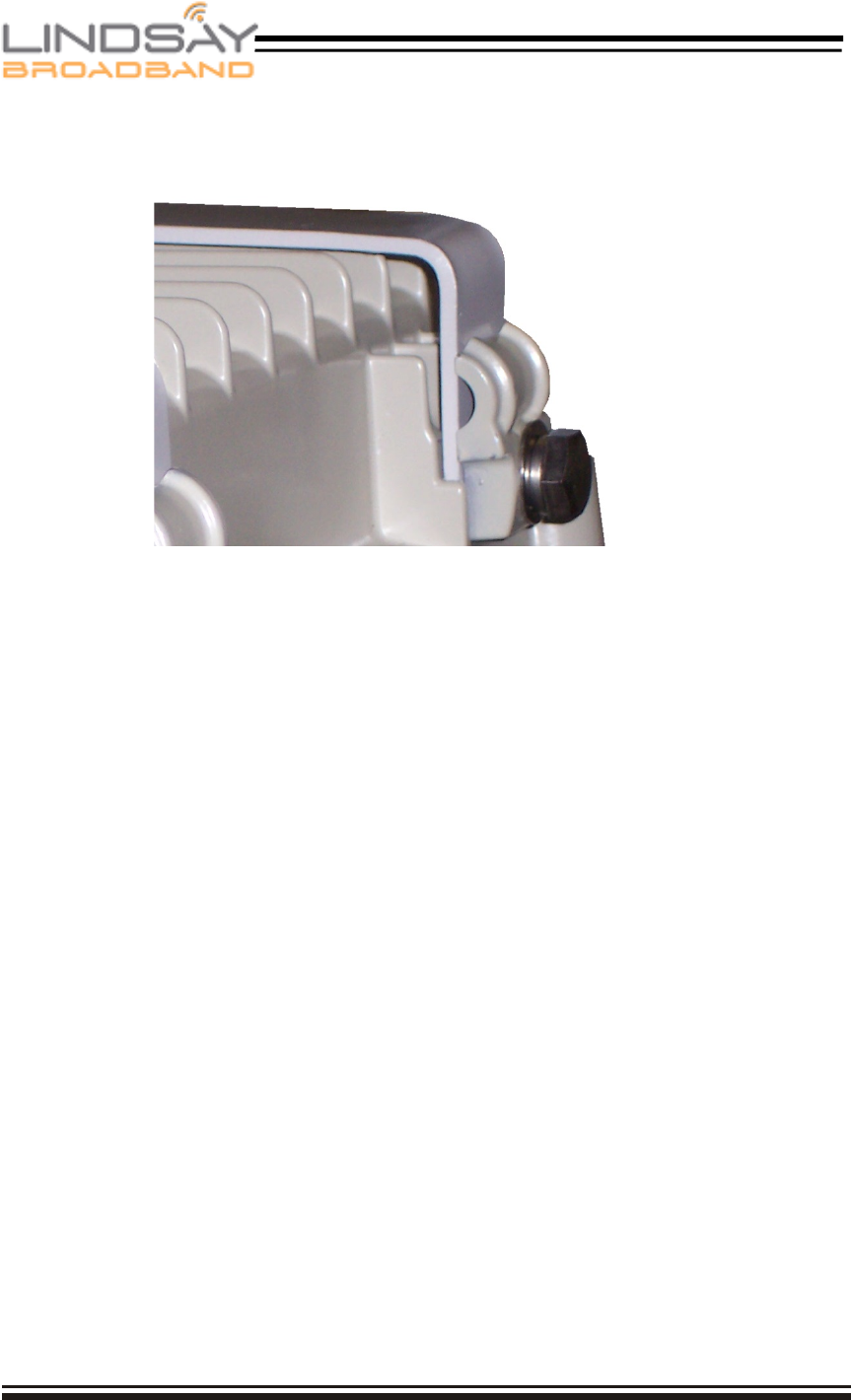
2/16/2016 6 of 13 Rev. 2
SMHAP-AP274
1.5 Hanger Bracket Detail
Base Mounted Hanger Bracket (PN 2-246)
Note: Bracket is installed between housing
and existing clamp.

2/16/2016 7 of 13 Rev. 2
SMHAP-AP274
SECTION 2 PRODUCT DESCRIPTION
2.1 Introduction
This section gives a full product description and a block diagram.
2.2 General Description
The SMHAP is an integrated, standards based, hardened solution for 802.11a/b/g/n/ac access
to the HFC DOCSIS network. It can be connected to the HFC network through any power-
passing tap, splitter, or coupler. This one-piece solution harbors a discrete cable modem and
a discrete Aruba AP-274 access point. Each piece is configured separately. The cable modem
is configured by your DOCSIS provisioning software. Consult Aruba’s literature for assistance
in configuring the AP
2.3 Housing
A rugged die cast aluminum housing of clamshell design is used. Externally, the housing base
has Installation mounts, a type F -20dB test point connector. and a 5/8” threaded opening for
KS type stinger pin connection to the HFC network
Internally, the housing base harbors the HFC interface board, the power supply, and the cable
modem.
The access point and antenna diplex filter occupy the housing lid. A low-profile “stealth”
antenna is attached to the lid.
Dual gaskets provide for EMI isolation and an airtight seal to 15psi. The housing can be strand
mounted. An optional hardware kit for wall, mast or pedestal mounting is available.
The station size is approximately 11.5 x 8.5 x 5 inches (290 x 220 x 130 mm). Its weight is
around 6.5 pounds (3Kg).
2.4 HFC Interface
The main circuit board, which is located in the housing base, provides the interface to the HFC
network. The following features are provided:
1. An AC/RF filter is used to separate the AC power from the RF carriers.
2. Plug-in SVP type surge protection.
3. Sockets for the separate padding of forward and reverse signals.
4. Test point. 20dB coupling of forward and reverse power at the cable modem
port.
5. A power director to disconnect power.
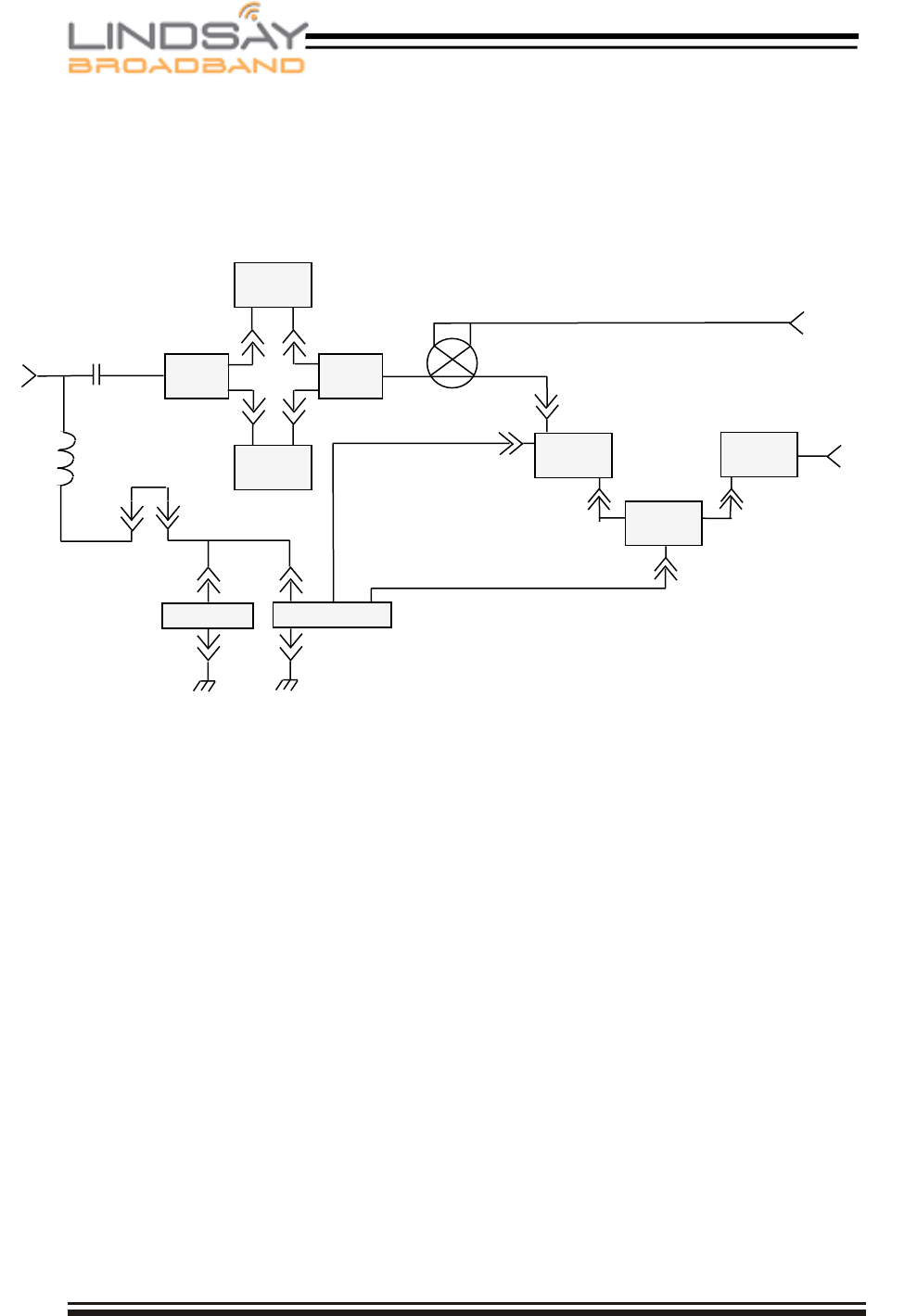
2/16/2016 8 of 13 Rev. 2
SMHAP-AP274
2.5 Block Diagram
Surge
SMPS
48V
PD1
AC / RF
Filter
Diplex
Filter
Diplex
Filter
Forward
Pad
Reverse
Pad
HFC
Test Point
Fwd. –20dB
Rev. –20dB
12V
Cable
Modem
WIFI
AP
Antenna
PoE
Inserter
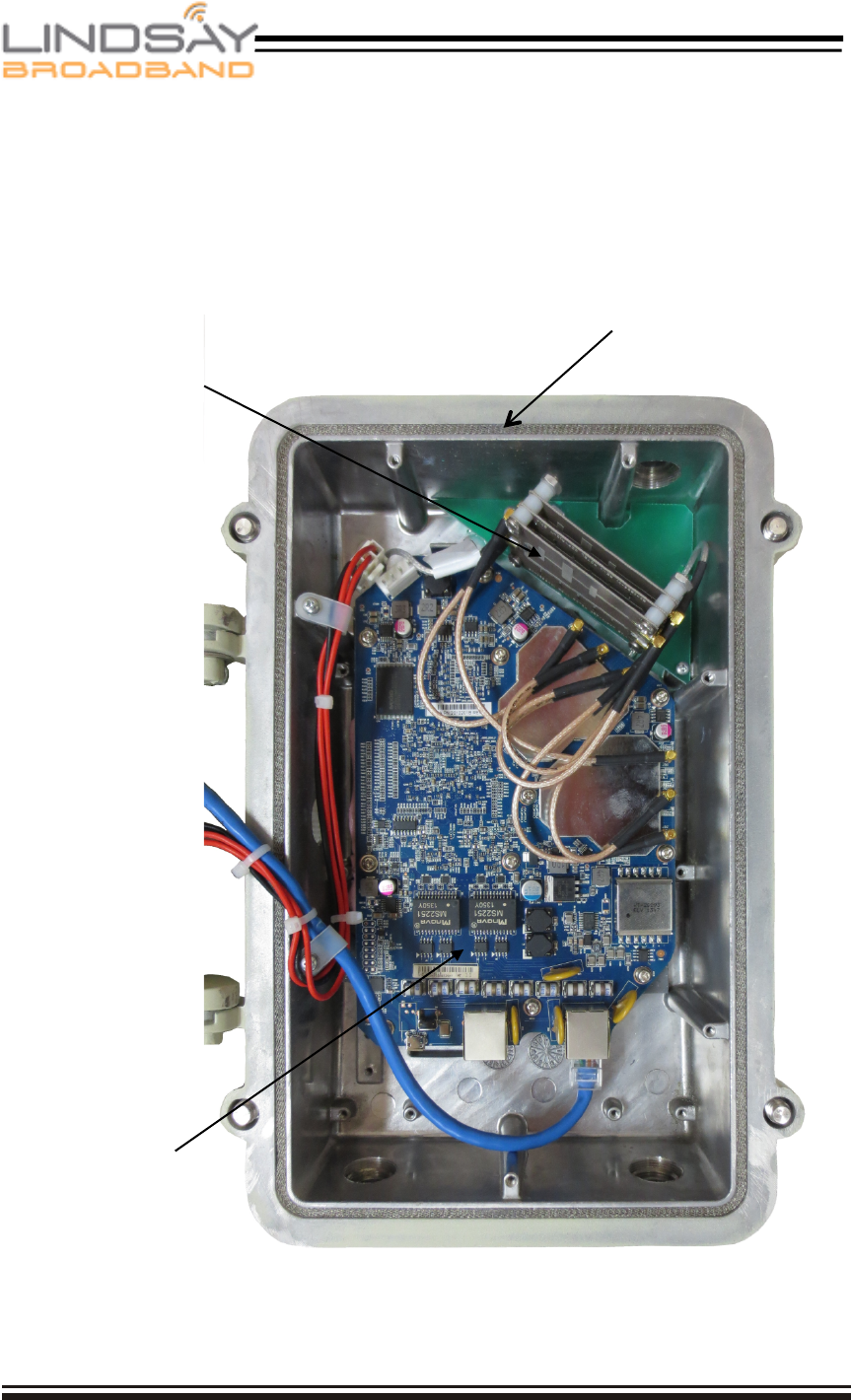
2/16/2016 9 of 13 Rev. 2
SMHAP-AP274
SECTION 3 COMPONENT IDENTIFICATION
3.1 Lid Component Identification Diagram
Diplex Filter
AP-274
EMI Mesh
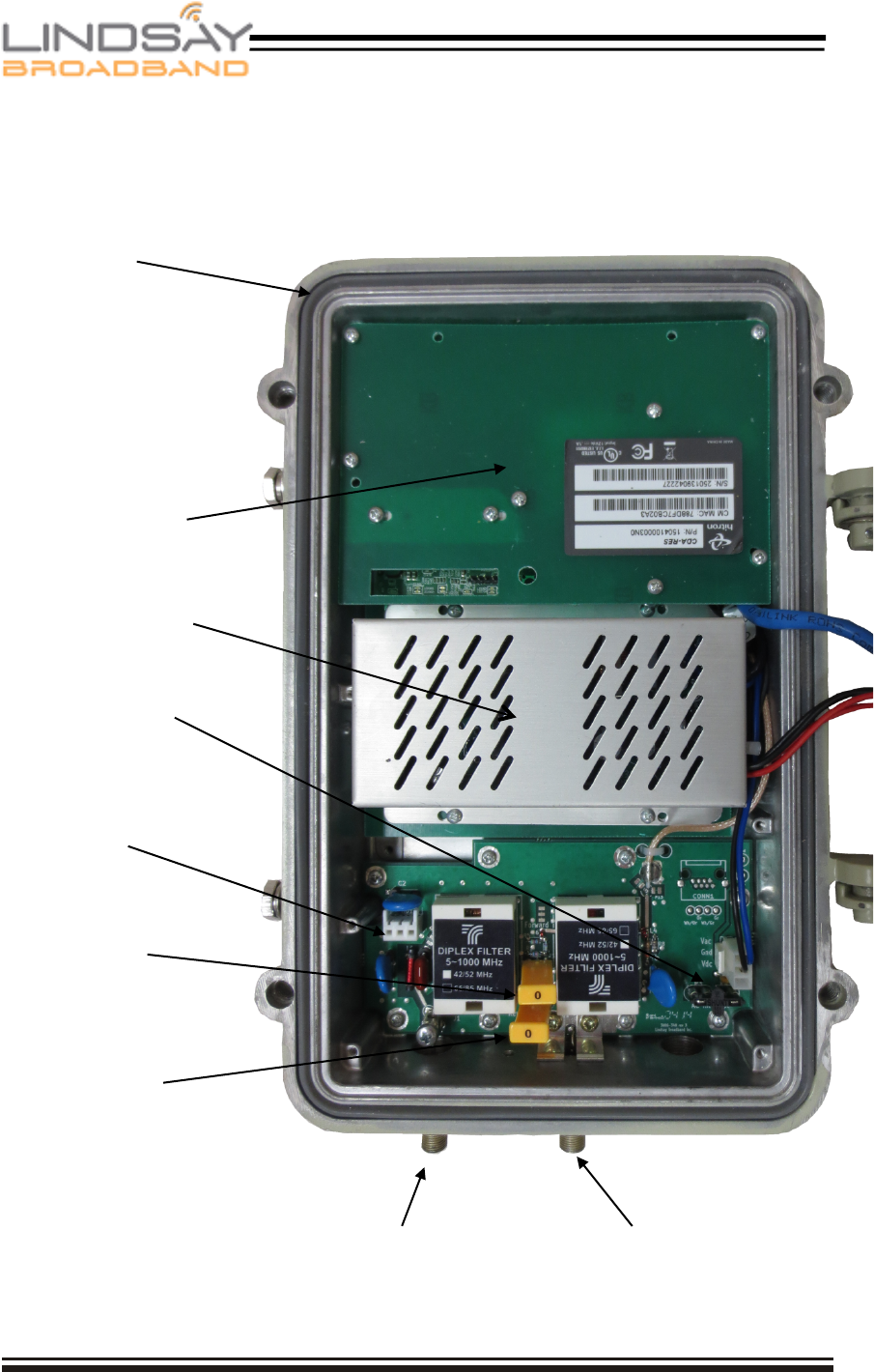
2/16/2016 10 of 13 Rev. 2
SMHAP-AP274
3.2 Base Component Identification Diagram
Cable Modem
Surge
Arrestor
Reverse
Pad
Test Point
HFC Input
Weather
Gasket
Forward
Pad
AC Interrupt
Power Supply
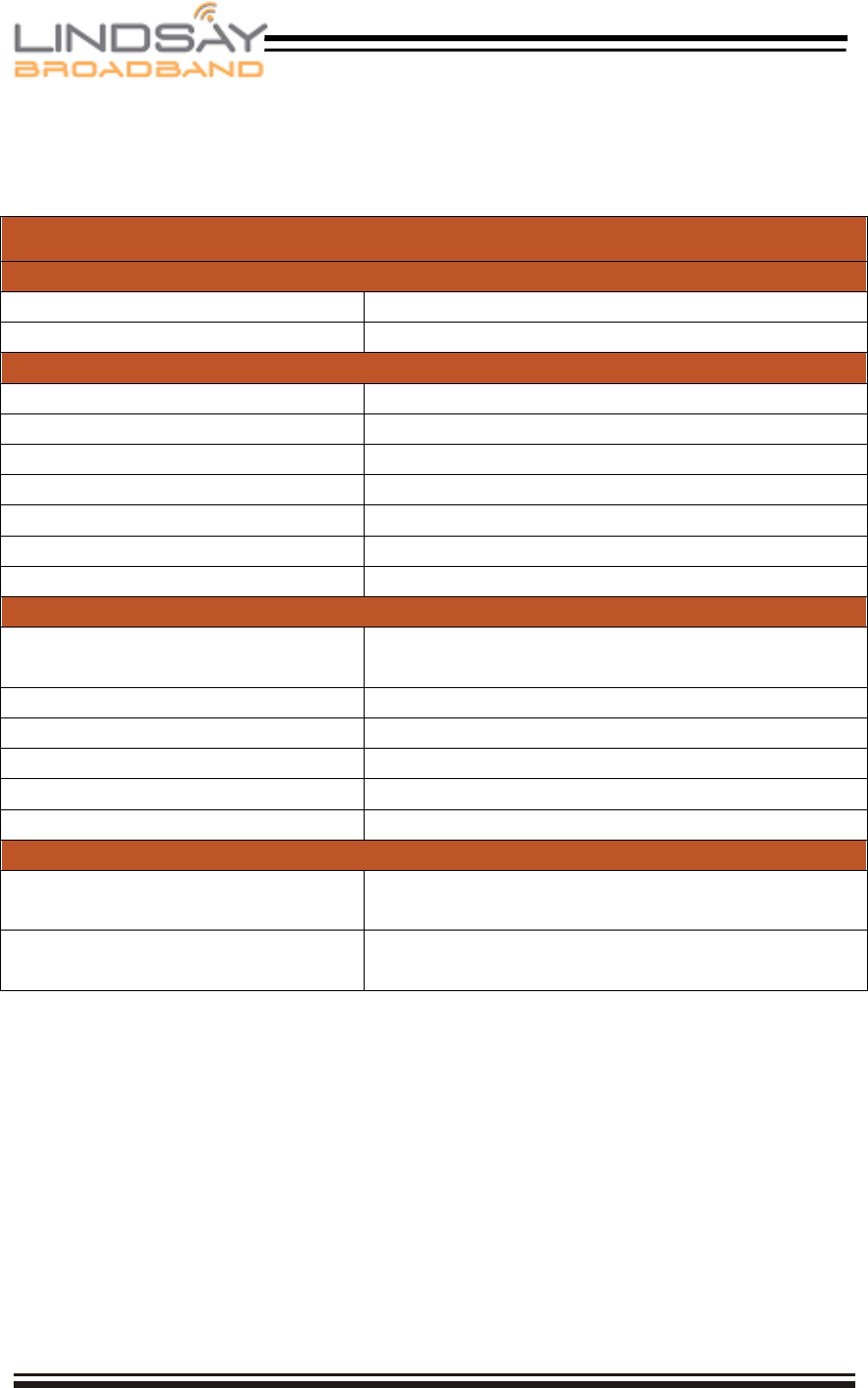
2/16/2016 11 of 13 Rev. 2
SMHAP-AP274
SECTION 4 PRODUCT SPECIFICATIONS
Lindsay SMHAP Specifications
Included Modules
Radio
Aruba AP274 (See next page)
Cable Modem
Arris SB6183 – See CM spec sheet.
HFC
Test Point
-20dB relative to cable modem RF port
Pad Type
JXP, Separate Forward and Reverse
Temperature Range
-40 to +60 Deg C
EMI Isolation
100 dB (5 to 1000 MHz)
Surge Withstand (HFC)
ANSI-IEEE C62.41 Category B3 (6KV)
Powering
60 / 90 Vac (Pseudo Sine)
Power Consumption
37 W
Physical
Dimensions
(excluding antenna)
290 x 220 x 130 mm (11.5 x 8.5 x 5 in.)
Weight
3 Kg (6.5 lbs.)
Installation
Strand, Mast, Wall, Pole, Pedestal
Housing Material
Die cast Aluminum Alloy
Salt Air Protection
Chromated and Painted
Airtight
IP68; 15 p.s.i.
Certifications
Radio
(see spec sheet for full list)
FCC Part 15 Certification
Industry Canada RSS Certification
Cable Modem
(see spec sheet for full list)
DOCSIS 3.0 Certified
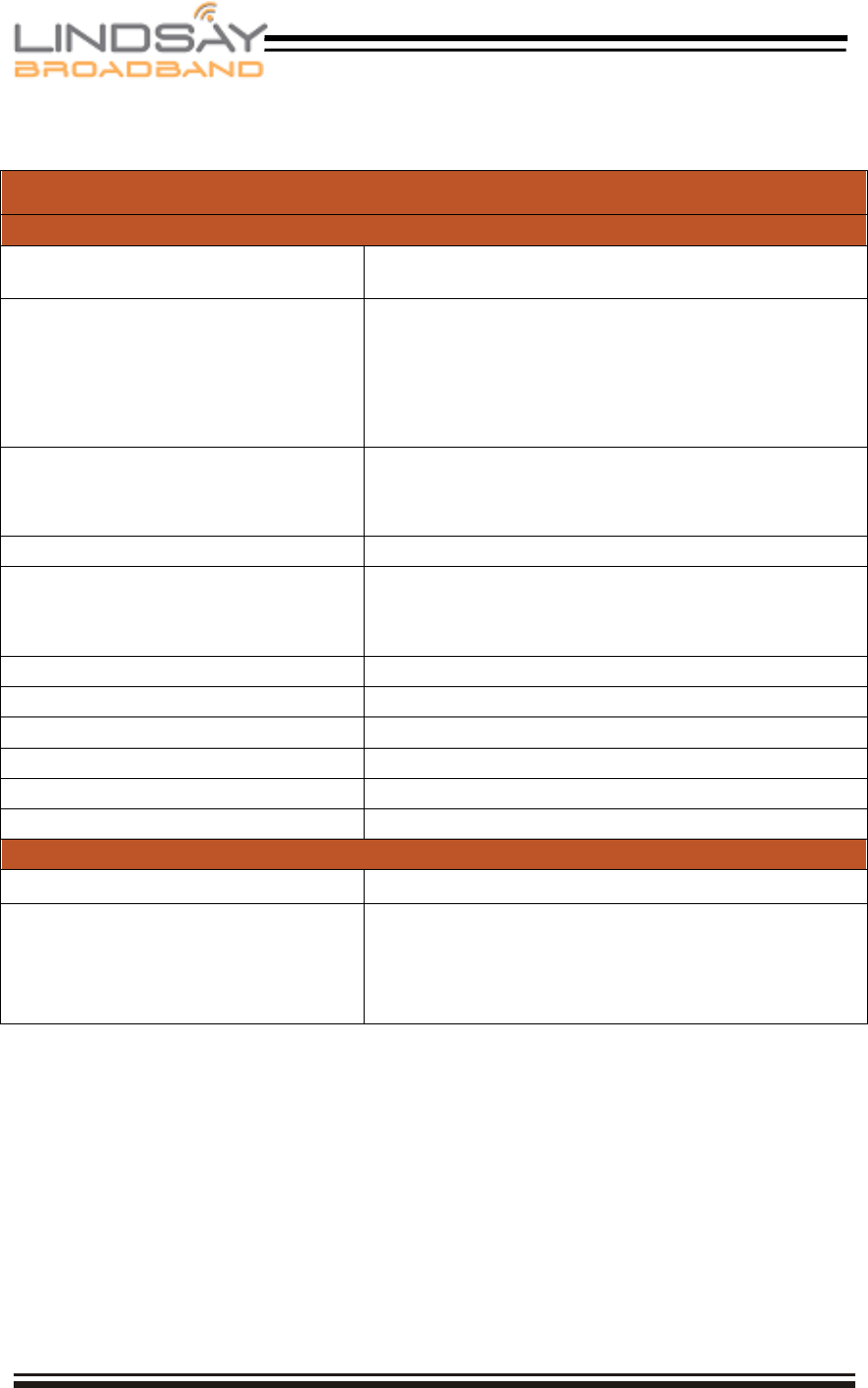
2/16/2016 12 of 13 Rev. 2
SMHAP-AP274
RF performance numbers are slightly lower due to additional internal RF circuitry.
AP-274 Specifications
Wireless
AP Type
Outdoor, dual radio, 5-GHz 802.11ac and 2.4-
GHz 802.11n, each with 3x3 MIMO
Frequency Bands
(Country specific restrictions
apply)
2.4000 GHz to 2.4835 GHz
5.150 GHz to 5.250 GHz
5.250 GHz to 5.350 GHz
5.470 GHz to 5.725 GHz
5.725 GHz to 5.875 GHz
Max Throughput
54 Mbps (802.11a/g)
450 Mbps (802.11n)
1300 Mbps (802.11ac)
Maximum Transmit Power
28 dBm (23 dBm per chain)
Receive Sensitivity
-95 dBm @ 1 Mbps
-75 dBm @ 54 Mbps
-61 dBm @ 1300 Mbps
Dynamic Frequency Selection
Yes
Spectrum Analysis Mode
Yes
Explicit transmit beam-forming
Yes
“ClientMatch” Real Time Steering
Yes
Wireless Intrusion Protection
Yes
Advanced Cellular Coexistence
Yes
Certifications
Certifications
Wi-Fi Alliance 802.11a/b/g/n/ac
Regulatory
FCC/Industry Canada, CE marked, R&TTE
Directive 1995/5/EC, Low Voltage Directive
72/23/EEC, EN 300 328, EN 301 489, EN 301
893, UL/IEC/EN 60950, EN 60601-1-1,
EN60601-1-2

2/16/2016 13 of 13 Rev. 2
SMHAP-AP274
SECTION 4 REGULATORY NOTICES
Industry Canada Notice for Licence-Exempt Radio Apparatus:
This device complies with Industry Canada’s licence-exempt RSSs. Operation is
subject to the following two conditions:
(1) This device may not cause interference; and
(2) This device must accept any interference, including interference that may cause
undesired operation of the device.
Le présent appareil est conforme aux CNR d’Industrie Canada applicables aux
appareils radio exempts de licence. L’exploitation est autorisée aux deux
conditions suivantes :
(1) l’appareil ne doit pas produire de brouillage;
(2) l’utilisateur de l’appareil doit accepter tout brouillage radioélectrique subi,
même si le brouillage est susceptible d’en compromettre le fonctionnement.
FCC Class B Part 15:
This device complies with Part 15 of the Federal Communications Commission
(FCC) Rules. Operation is subject to the following two conditions:
• This device may not cause harmful interference.
• This device must accept any interference received, including interference
that may cause undesired operation.
This equipment has been tested and found to comply with the limits for a Class B
digital device, pursuant to Part 15 of the FCC Rules. This equipment generates,
uses and can radiate radio frequency energy and, if not installed and used in
accordance with the manufacturer’s instructions, may cause interference harmful to
radio communications.
If this equipment does cause interference, which can be determined by turning the
equipment off and on, the user is encouraged to try to correct the interference by
one or more of the following measures:
• Reorient or relocate the receiving antenna.
• Increase the separation between the equipment and receiver.
• Connect the equipment to an outlet on a circuit different from that to which
the receiver is connected.
• Consult the dealer or an experienced radio or TV technician for help.
Warning: The FCC Regulations state that any unauthorized changes or
modifications to this equipment not expressly approved by the manufacturer could
void the user's authority to operate this equipment.